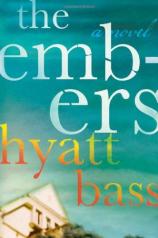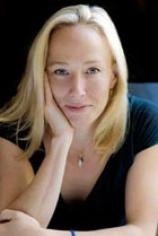Author Talk: July 10, 2009
AUTHOR TALK
July 10, 2009
In this interview, feature film director/screenwriter Hyatt Bass discusses the inspiration behind her debut novel, THE EMBERS, and explains how it evolved from its origins as a screenplay to a book. She also muses on what initially drew her to writing fiction, and names some of the novels and their authors who helped influence her own work.
Question: What sparked the idea for THE EMBERS?
Hyatt Bass: THE EMBERS actually started as a screenplay. I was editing my first feature film, Seventy-Five Degrees in July, and in a restaurant one day, I saw a precocious-looking New York adolescent girl wearing an oversized men’s blazer and carrying a stuffed animal backpack. I’ve always been fascinated by adolescent girls, and thought she would make an interesting subject for my next film. So I immediately started forming this character (now split in the book between Ingrid and young Emily). At the same time, I was completely blown away by the performance of one of the actors in my film --- Harris Yulin --- and I thought that whatever movie I made next had to feature him fairly prominently. I began working on a story about an unlikely friendship between a teenage girl on the cusp of adulthood waking up to all kinds of things --- romance and independence and fantasies of where her life will take her --- and an elderly man nearing the end of his life, looking back with nostalgia and yearning, but also thinking about what he might have done differently. I liked the contrast between them, and the idea that, different as they are, they might strangely find comfort in one another.
Q: Can you talk a little about how THE EMBERS evolved from a screenplay into a novel?
HB: Somehow, from the very beginning, the whole concept felt more like a novel than a film. But since I was a filmmaker, I brushed that idea aside and went ahead with the screenplay, all the while writing notes in the margins --- “If a novel….” In the end, the screenplay didn’t work at all, and so I figured I had nothing to lose.
Once I started writing the story as a novel, it was tremendously liberating. I had no page limit, and I could delve much deeper into each character. Soon, the friendship between Joe and this young stranger, Ingrid, turned into more of an exploration of the relationship between him and his daughter, Emily. As Emily and the rest of Joe’s family began to spring up around him, the Aschers took over the novel. I thought about a Van Gogh quote I’d read a few years before: One may have a blazing hearth in one’s soul, and yet no one come to sit by it. This really captured the way I thought about the Aschers and the state of isolation they’re all living in, yearning for closeness but unable to connect. Out of the quote, too, came the title of the book.
The funny thing is I now think the book would make a great film.
Q: Is the book autobiographical at all? Do the Aschers mirror your own family in any way?
HB: Obviously my own life experiences inform the way I write, but I’m not really interested in writing about my own life. The fun of fiction for me is being able to take something --- from my life, or someone else’s, or even from a book or a movie --- and use that as a jumping-off point, but say, what would happen if things went completely differently here, or if things were taken to the furthest extreme? I’m very close to my family --- my mom and my dad and my sister --- but like all families, I think, we have our moments of frustration with one another, and moments when we have difficulty communicating, and that’s something I’ve taken to an extreme in the book. Also, I started writing this book right after my husband and I got married, and during the seven years it took me to finish writing it, we had two children. So my whole concept of family changed as I went from being my parents’ child to also being my children’s parent. The experience gave me a new understanding of family and parenting, and I definitely began to look at my past through a different lens, which undoubtedly affected the book in ways I probably still don’t completely grasp.
Q: Emily, Joe and Laura are all grappling with unresolved issues of their past. While writing, did you find yourself sorting through issues of your own past?
HB: When I was young, I had a couple of friends who died of cancer --- one of them was about 10 and the other 16, I think. They were both boys, and really really good people, as well as close to my age. Their deaths were so shocking, and continue to haunt me. I’ve always wondered what it would feel like to be the surviving sibling or the parent, and how a family weathers a severe tragedy like that, and I obviously used the book as a way to sort through some of that.
Another thing I don’t think I was aware of exploring, but that I now feel really influenced the book was that my parents had sort of a high profile in the town where I grew up, and so people thought they knew a lot about our family --- and about me --- before they even met me. There were certain assumptions and judgments made about me that were often not true at all, and I think I put a lot of my feelings about that into the book, especially into Joe’s story. I also think the self-consciousness I felt growing up is one of the things that attracted me to writing fiction in the first place because it’s a very safe way to bare your soul. You choose exactly what you want to convey and how you want to convey it, without the vulnerability of standing face to face with someone who might be judging you or dismissing you based on some preconceptions of your reality.
Q: What inspired the use of Joe’s Dictaphone as a storytelling device?
HB: Sometime just before I started the book, I saw a production of Beckett’s Krapp’s Last Tape, and the whole play is just this one old guy, sitting at a desk, listening to all these tapes he made as a younger man. I loved the idea of the past and present colliding in that way --- the older man confronted with his younger self.
Also, when I was growing up, my parents didn’t have a video camera, but they would sometimes make audio tapes of me and my sister. There is something about the absence of picture --- just that voice suddenly speaking out of a machine --- that is so magical. Now that I think of it, it’s kind of like reading a novel in the sense that there is so much left for your imagination to flesh out.
Q: Why did you choose to rotate between the different family members’ perspectives, and shift back and forth between past and present, instead of sticking with a single main character and telling his or her story in a linear fashion?
HB: Well, I definitely wouldn’t have done it if I’d had any concept of how complicated it would make things for me --- or how long it would take to write the book that way. But it’s been sort of an obsession of mine to always look at things from different people’s points of view --- maybe because I don’t like conflict, so it’s a way of keeping myself out of fights. I don’t really know. For the book, though, it was really important for me that there were no heroes and no villains, and that each of the three main characters share responsibility for the family’s downfall. In shifting from one person’s perspective to another --- and also back and forth between past and present --- I started thinking of the family sort of like a sculpture, which is slowly rotating, so that you are constantly surprised, and constantly changing your concept of who these people are, and what their true story is. I tried to do that by not just dwelling on this tragedy, but by giving each character soft, sweet moments, and also plenty of humorous moments --- sometimes funny for them as well, and other times only for us as outsiders, observing behavior we laugh at not only for its absurdity but for its universal familiarity.
Q: Are there any books that were particularly influential to you while you were writing THE EMBERS?
HB: When my husband and I were on our honeymoon, I read Michael Cunningham’s THE HOURS. At that point, I had finished my screenplay, knew it wasn’t working, and was toying with the idea of turning it into a novel. After reading THE HOURS, I was so inspired by the ingenious linking of the characters, the attention to detail, and the gorgeous wording, I just sat down and wrote the first fifty pages of THE EMBERS. Then, at different points when I was writing the novel, I had conversations with two friends, who each recommended a book they thought sounded similar to what I was writing. One of them was William Styron’s LIE DOWN IN DARKNESS, and the other Susan Minot’s MONKEYS. All three of these are now among my very favorite books and authors. LIE DOWN IN DARKNESS was a big influence in terms of the way I structured THE EMBERS, and because it was recommended so early in the process and was similar in many ways to the book I had in mind, and was just so incredibly great, it really influenced the content of the book and the way I shaped and structured the story. My discovery of MONKEYS, as well as Minot’s EVENING, came a little later in the process when I was about a year in, just finishing the first draft. Minot’s observations of human behavior, and the kindness and understanding she brings to each of her characters, are something I aspire to; and her ability to craft stories that are so quietly moving and brilliantly real made her work --- more than any other writer’s --- a touchstone for me throughout this process.
Also, looking back, there are books that were very important for me when I was younger, and which I think must have influenced me because I can see glimmers of them in THE EMBERS. Those books are Pat Conroy’s PRINCE OF TIDES, Judith Guest’s ORDINARY PEOPLE, and J. D. Salinger’s FRANNY AND ZOOEY. Lastly, whenever I’m writing, I constantly refer to Raymond Carver’s work to remind myself to try to pare back and keep the language sparse and simple. But he’s an absolute genius, and the operative word there is try.
© Copyright 2009, Hyatt Bass. All rights reserved.
• Click here now to buy this book from Amazon.




